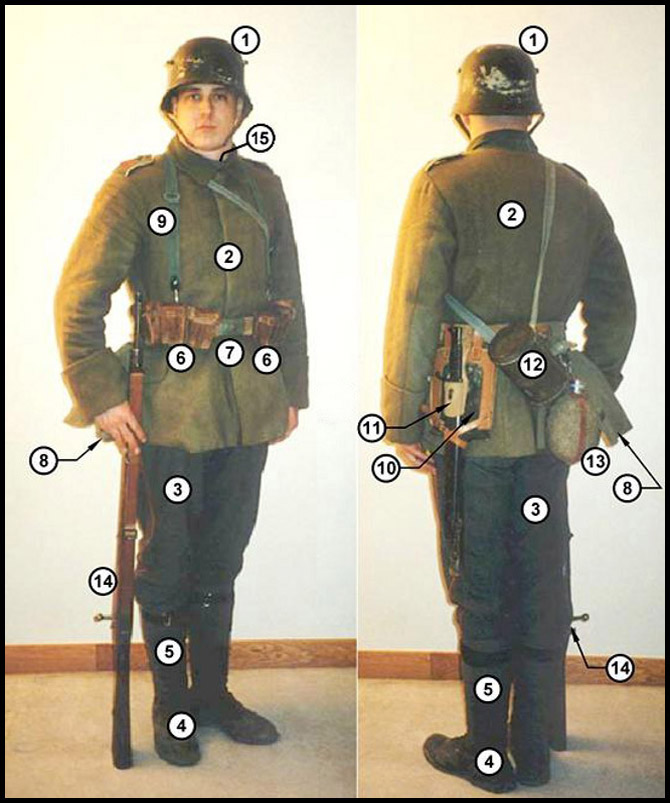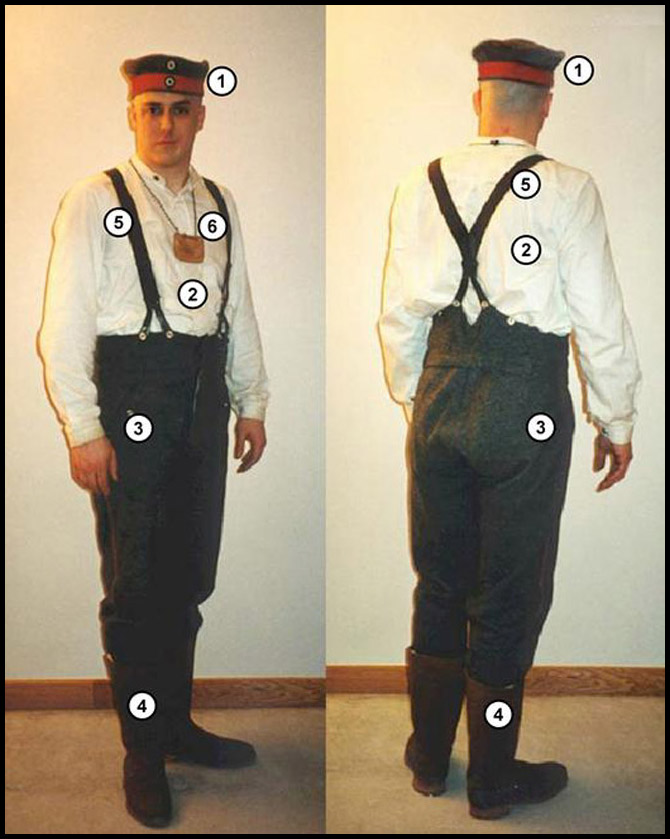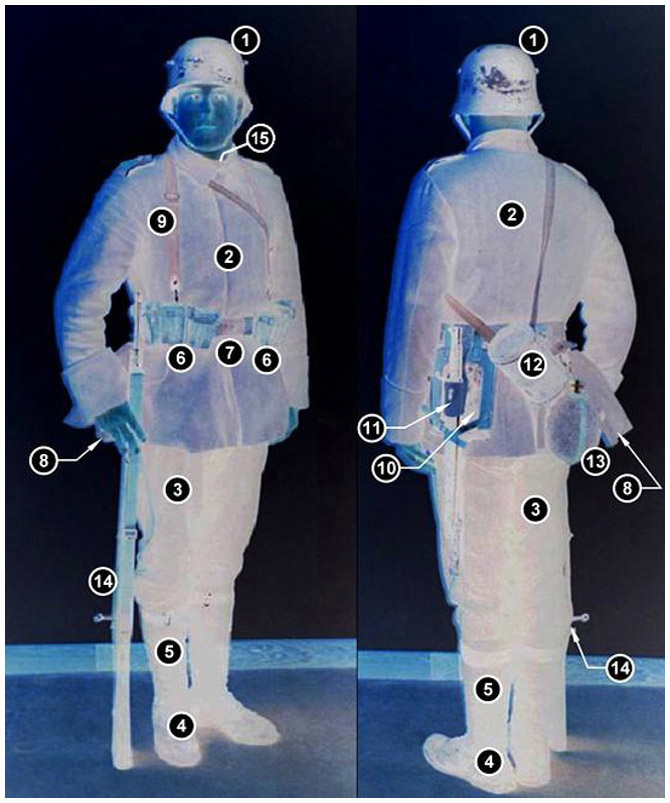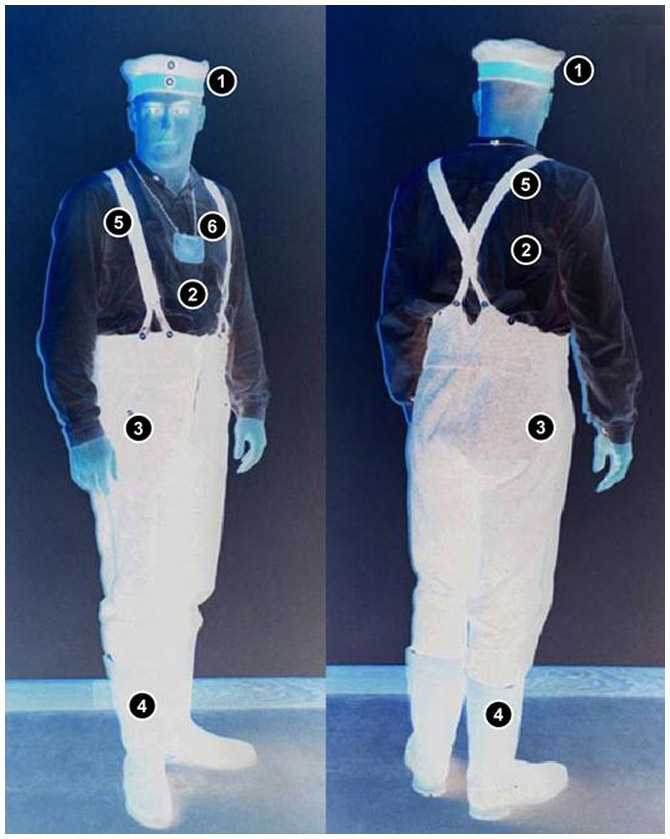Main Menu

IR63's Minimum Uniform & Equipment Requirements
The following short descriptions will provide a guideline with which members can choose their uniforms and equipment items. For a more detailed description and pictures of the original items, just click on the item in the picture, or the name in the descriptions below.
In the detailed descriptions, only photos of original items have been used. Reproductions vary due to materials available and information available, sources/manufacturers come and go, etc. and we have chosen to show what is ideal. Upon joining the unit, you will be provided an approved Vendor's list and your sponsor will discuss your options.
It should be understood that any questions regarding the acceptability of any given uniform part or equipment piece rests with the Kompagnieführer and NCOs of JR63. Members with specific questions should check with their sponsor for precise explanation of JR63 policy, especially before buying any piece of equipment that may not meet JR63 standards.
IR63 Minimum Kit
The items listed in this section are the essential kit items required to participate at combat events with IR63. Before you can be voted in as a full member of JR63, you must satisfy your membership dues and own these items.
1917-18 Combat Order - Standard Rifleman

- M.1916/17/18 Stahlhelm (steel helmet) The steel helmet employed by the German army in WWI came in three basic models, with the main difference being the configuration of the liner. The M.1916 u. M.1917 used M.1895 Pickelhaube chinstraps with the M16 having a leather band liner while the M17 used a steel band. The M.1918 used a steel band liner practically identical to the M.1917 but with a new two-piece chinstrap with ends that connected under the chin with spring clip.
- M.1915 "Bluse" (Tunic) The Bluse was made in a new darker Feldgrau (field grey) wool then previous tunics. It had a fall collar faced with a lighter Resedagrün (pea-green) material. The six large front buttons were concealed by a fly, and it had two slanted, flapped side pockets. The shoulder straps were narrower, and detachable; nevertheless, they were often sewn firmly down to the shoulders to prevent snagging. They were piped white for infantry and bore the regimental number or monogram in red chain-stitched embroidery. Members of JR63 may also purchase the M1907/10 Waffenrock or the M1914 Vereinfachte Feldrock.
- M.1917 Hosen (trousers) in Feldgrau (field grey) wool, reintroducing this color to trousers which had been abandoned in 1914. By this stage of the war, the cloth was being woven out of ersatz fibers for economic reasons -even nettle fibers were used - and was of poor quality.
- M.1914 Schnurschuhe (ankle boots) in brown or black rough-out leather, laced up with eyelets and hooks. Ankle boots must be used with Gamaschen (Note: You do not have to own Schnurschuhe und Gamaschen, you can use Marschstiefel instead.)
- Gamaschen (puttees), now made out of any available cloth, German or Allied, of a wide range of drab shades.
- M.1909 Patronentaschen (cartridge pouches) in pebbled-finish brown or black leather. Each of the six pouches, in two sets of three, holds three five-round clips of 7.92x57mm cartridges, giving a total of 90 rounds. The weight is distributed by means of a ring mounted behind each triple pouch, hooking to the ends of the Brotbeutelriemen (breadbag strap) looped over the neck.
- M.1895 Koppel und Koppelschloß (belt and belt buckle) the belt would have been rough out either natural oiled or blackened and the buckle would be the M.1915 grey-painted Prussian steel.
- M.1887 Brotbeutel (breadbag or haversack) made of ochre or grey cloth; it looped to the belt by two buttoned cloth straps and a central metal hook. Two rings on the inner face allowed the attachment of a sling so that it could also be worn slung round the body. The Brotbeutel accommodated rations and eating utensils as well as small personal effects.
- M.1887 Brotbeutelriemen (breadbag strap) made of ochre or grey cloth; it has a spring clip on each end to attach to the "D" rings on the back of the breadbag to carry it like a haversack, or more commonly it was looped over the back of the neck and attached to the two "D" rings on the back of the ammo pouches to support the weight.
- Kleiner Spaten oder Schanzzeug und Schanzzeugtasche (entrenching tool & carrier), looped to the left side of the belt by the M.1898 leather carrier. The carrier would be natural oiled or blackened; the lower straps of the carrier also secured the bayonet scabbard to the spade handle.
- M.1898/05 Seitengewehr (called the "Butcher" bayonet) The bayonet would have been plain "in the white" steel and the scabbard would have been blued steel.
- M.1917 Lederschutzmaske (gasmask), in waterproof leather with a filter cartridge. Its Feldgrau painted metal canister was slung on a fabric or papercloth strap.
- M.1915 Feldflasche (canteen) of cloth-covered enameled steel with a cork, hooked to the breadbag.
- M.1898 Mauser Gewehr 98 (rifle '98), in 7.92x57mm caliber. For IR63 we can use either the early war configuration with the marking disk on the buttstock and no finger grooves in the forestock, or the later model with bolt take-down lug in the buttstock and the finger grooves.
- Halsbinde (neck stock) in grey or grey-green cloth, tied around the neck to protect the wool collar from sweat and wear.
1917-18 Casual Kit (What the barbaric Hun sports under his tunic)

- M.1910 Feldmütze (field cap) in field grey cloth, its band and piping in the distinctive arm-of-service color, here in the red of the infantry. Two small pressed metal cockades are sewn to the front: on the crown were the national colors of black, white and red, and on the band were the colors of the regiments' state of origin (here the black and white of Prussia). After the first year or so of the war, this cap was usually only worn behind the lines. In 1917, a drabber version of the Feldmütze, called the M.1917 Einheitfeldmütze with an "all-arms" Resedagrün (pea-green) band was introduced, but the old style Feldmütze continued in use alongside it, usually with a drab-colored cloth strip fitted over the red band.
- M.1907/10 Hosen (trousers) in Steingrau (Stone-grey) cloth with 4mm red wool piping on the outside seams.
- Hemd (Issue shirt) 2 or 3 button off-white canvas/cotton drill issue shirt, sleeves would be shorter so as not to show from under tunic sleeves and would be 10" past the crotch in length as they doubled as night shirts.
- M.1886 Marschstiefel (marching boots) in tan leather, rough side out. (Note: You do not have to own Marschstiefel, you can use Schnurschuhe und Gamaschen instead.)
- Hosenträger (Suspenders) with leather ends.
- Erkennungsmarke (ID Disk) in leather pouch with twisted black & white (for Prussian) neck cord. (Note: ID Disks are issued by the unit when recruits complete their probation.)
Items required for participation in IR63, but not shown above:
- M.1893 und M.1916 Trinkbecher (Drinking Cup) M1893 aluminum cups or the enameled steel M.1916.
- Eßbesteck (Spork/Eating utensil) A tinned steel spoon and fork joined together with a rivet.
- M.1910. M.1915 or M.1917 Kochgeschirr (mess kit) M.1910 in aluminum or the M.1915/17 enameled steel.
- Soldbuch (Individual pay book) The paybook will be issued to recruits when they complete their probationary period.
- Decke (Blanket) Made from wool, issued examples vary in color, pattern and size. Any standard all wool blanket, of a nondescript color and free of markings and modern materials (like nylon edging) should be acceptable. Recruits of IR63 are not actually required to purchase one, but try sleeping in a cold trench or bunker without one!
- Unterwäschausruf (Underwear) You have to have something under your uniform! No one will see you undressed (most likely), but it never hurts to be prepared and have something period.

